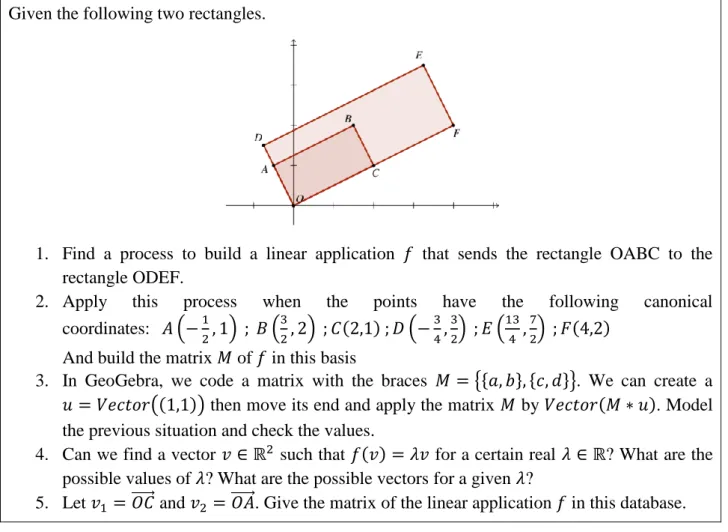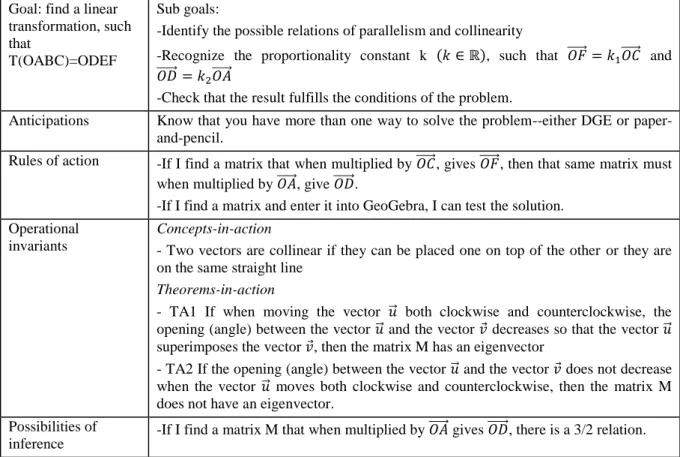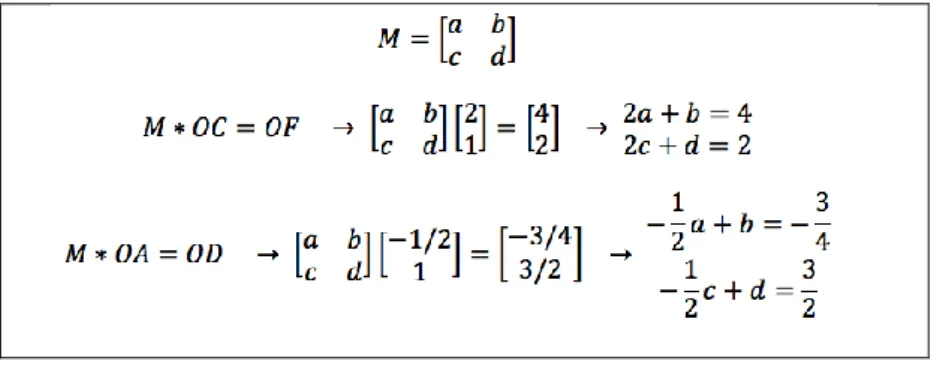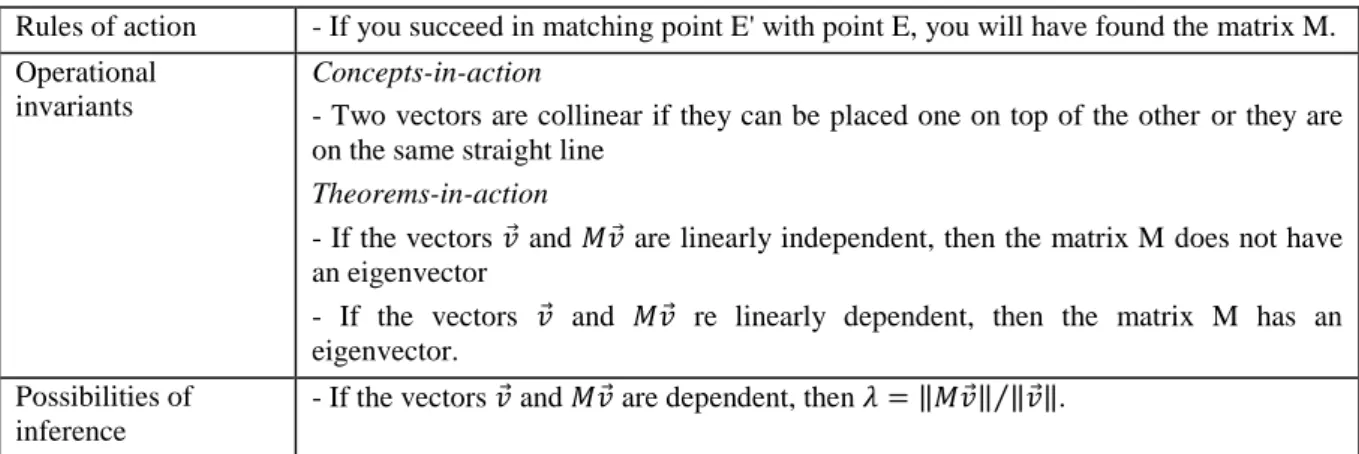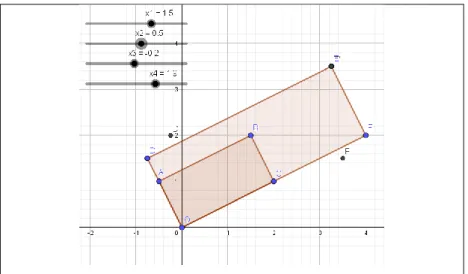HAL Id: hal-02428727
https://hal.archives-ouvertes.fr/hal-02428727
Submitted on 6 Jan 2020
HAL is a multi-disciplinary open access
archive for the deposit and dissemination of sci-entific research documents, whether they are pub-lished or not. The documents may come from teaching and research institutions in France or abroad, or from public or private research centers.
L’archive ouverte pluridisciplinaire HAL, est destinée au dépôt et à la diffusion de documents scientifiques de niveau recherche, publiés ou non, émanant des établissements d’enseignement et de recherche français ou étrangers, des laboratoires publics ou privés.
Students’ perceptions in a situation regarding
eigenvalues and eigenvectors
José Orozco-Santiago, Carlos-Armando Cuevas, Luc Trouche
To cite this version:
José Orozco-Santiago, Carlos-Armando Cuevas, Luc Trouche. Students’ perceptions in a situation regarding eigenvalues and eigenvectors. Eleventh Congress of the European Society for Research in Mathematics Education, Utrecht University, Feb 2019, Utrecht, Netherlands. �hal-02428727�
Students’ perceptions in a situation regarding eigenvalues and
eigenvectors
José Orozco-Santiago1, Carlos-Armando Cuevas1 and Luc Trouche2
1
Center for Research and Advanced Studies of the National Polytechnic Institute (Cinvestav-IPN), Mexico; jorozco@cinvestav.mx, ccuevas@cinvestav.mx
2Institut français de l’Education, ENS de Lyon-, France;
luc.trouche@ens-lyon.fr
In this study we investigate conceptualization processes among university students in solving a problem involving concepts of eigenvalues and eigenvectors in a linear algebra course for engineering. In the pilot phase of the study, we examined a case study of two first-year linear algebra students and analyzed the data through the theory of instrumental genesis in a dynamic geometry paper-and-pencil environment.
Keywords: Linear algebra, Eigenvalue, Eigenvector, Scheme, Instrumental genesis.
Introduction
Linear algebra is one of the first abstract mathematics courses engineering students take in their early years in college. According to Robert and Robinet (1989), when first encountering linear algebra, students express concern about the use of formalism, the overwhelming number of new definitions and the lack of connection between this new field and their existing knowledge of mathematics. Dorier and Sierpinska (2001) distinguish two inseparable sources of difficulty for students in learning processes: the nature of linear algebra itself (conceptual difficulties) and the kind of thinking necessary for the understanding of linear algebra (cognitive difficulties).
After the Linear Algebra Curriculum Study Group (LACSG) recommended the use of technology in early linear algebra courses (Carlson, Johnson, Lay, & Porter, 1993), some teachers began to incorporate Computer Algebra Systems (CAS) into their classrooms. At the same time, several researchers studied the reflexive use of technological tools in classroom teaching/learning processes (involving both the tool and the mathematical content), which gave rise to the instrumental
approach to didactics as a central theoretical framework (Artigue, 2002; Guin, Ruthven, &
Trouche, 2005; Trgalová, Clark-Wilson, & Weigand, 2018).
Eigenvalues and eigenvectors are important concepts in the study of linear algebra (Gol Tabaghi, 2014; Meel & Hern, 2005), and they require an understanding of other concepts such as vector spaces, linear transformation, bases and dimension, among others. In this paper, we present the preliminary results of our doctoral research, whose objective is to orchestrate a teaching situation appropriate for introducing the concepts of eigenvalues and eigenvectors in a traditional course on linear algebra. For this part of our research, we pose the following question: what utilization schemes does the student experience / develop when faced with a geometry task involving the concepts of eigenvalues and eigenvectors?
Theoretical framework
The French mathematics education community (Artigue, 2002; Guin et al., 2005) has extended the instrumental approach (Rabardel, 2002) to the learning of mathematics through the reflexive use of technological tools. Rabardel thus defines an instrument as a “mixed entity made up of an artifact
and a scheme” (p. 37), retaining Vergnaud’s notion of scheme, as “the invariant organization of behavior for a certain class of situations” (Vergnaud, 1998, p. 167). To understand the function and dynamic of a scheme, we must take into account its components. These include one or several goals, each with its sub-goals and anticipations; rules to generate action, information seeking and control; its operational invariants (concepts-in-action and theorems-in-action); and the possibilities of inferences within the situation. Artifacts are associated with two kinds of utilization schemes: usage schemes and instrument-mediated action schemes. Two different users can approach the same artifact differently, develop different utilization schemes, and create two different activities and instruments (Alqahtani & Powell, 2017, p. 14). For a subject, the artifact becomes an instrument through a process, called instrumental genesis, “involving the construction of personal schemes or, more generally, the appropriation of social pre-existing schemes” (Artigue, 2002, p. 250). According to Trouche (2004), instrumental genesis is a complex process that requires time, and is related to artifact’s characteristics and the subject’s activity. In instrumental genesis, two processes coexist: instrumentalization and instrumentation. “The instrumentation process is the tracer of the
artifact on the subject’s activity, while the instrumentalization process is the tracer of the subjects’ activity on the artifact” (Trouche, 2014, p. 311). In a technological environment, interactions between student and artifact must be organized with specific didactic intentions. The crucial role of teachers in this process was soon recognized. To characterize the teacher’s role in guiding students’ mastery of tools and their learning processes, Trouche (2004) introduced the notion of instrumental
orchestration. An instrumental orchestration consists of two main elements: didactical
configuration and exploitation modes.
Methodology
In this paper we present the results of a single task, part of a larger study whose objective is to design an orchestration of a situation to introduce the concepts of eigenvalues and eigenvectors in a first course on linear algebra for engineering students. The task was designed by the teacher, in conjunction with the researcher. The study was carried out in the spring of 2018 and included a case study. The research involved eight volunteer students averaging nineteen years old, all enrolled in a "Fondamentaux des Mathématiques II" class at a public university in France. The session lasted 120 minutes. The students had experience in matrix calculation, vector spaces, and linear transformations, but they had not yet addressed eigenvalues and eigenvectors. They also mentioned having some previous experience with the Dynamic Geometry Environment (DGE), in this case GeoGebra. The students were told that we would be studying the way they solved the problem, or the techniques used, and that they would not be graded. Each student was given the paper assignment and each group (of 2 or 3) was provided with a laptop with GeoGebra and Internet access. The data was collected from observation and field notes by a researcher external to the experiment, and lasted about 120 minutes. For our analysis, we selected two students: Cécile and Henry.
Mathematical context and task design.
An eigenvector of an matrix is a nonzero vector such that for some scalar . A scalar is called an eigenvalue of A if there is a nontrivial solution of ; such an is called an eigenvector corresponding to (Lay, Lay, & McDonald, 2016). Here we consider ,
by the availability of a DGE (GeoGebra), considering the potentiality of the dragging tool “wandering dragging” (Arzarello, Olivero, Paola, & Robutti, 2002).
The task (see figure 1) was not designed to evaluate the student’s progress in the course. Rather, it was restricted to having the students to work on in order to study their conceptualization of eigenvalues (real) and eigenvectors of 2x2 matrices, specifically in solving the first two points in a single class period of 30-50 minutes.
Given the following two rectangles.
1. Find a process to build a linear application that sends the rectangle OABC to the rectangle ODEF.
2. Apply this process when the points have the following canonical coordinates:
And build the matrix of in this basis
3. In GeoGebra, we code a matrix with the braces . We can create a then move its end and apply the matrix by . Model the previous situation and check the values.
4. Can we find a vector such that for a certain real ? What are the possible values of ? What are the possible vectors for a given ?
5. Let and . Give the matrix of the linear application in this database.
Figure 1. The task discussed in this document
The students are invited to develop intuitive notions of eigenvalues and eigenvectors associated with the matrix M, in the environment of GeoGebra, by means of a draggable vector and its vector image , as the vector is dragged around the screen, the vector moves accordingly. To find an eigenvalue of the matrix M geometrically, the student will have to drag a position where and are collinear, in order to explore the relationship involved in the equation , and to recognize that there is an infinite number of eigenvectors associated with each eigenvalue.
Instrumental orchestration of the class
The main objective of the orchestration is to introduce and use the concepts of values and eigenvectors in a first course on linear algebra. The secondary objective is to analyze a geometric problem in a paper-pencil environment and in a DGE to explore the problem and validate the solutions proposed by the students. It is defined by a didactical configuration (students organized in heterogeneous working groups, with access to GeoGebra) and exploitation modes (each group
analyzes the problem and proposes solutions using a combination of paper-and-pencil work and GeoGebra; the group is free to ask questions of the teacher and each participant’s role is identified).
Data Analysis
The students followed the steps given in the task. Question # 1 can be identified as the phase of data selection, solution strategies and operation to be performed to solve the task:
A transformation (matrix) that stretches the rectangle horizontally and another transformation (matrix) that stretches it vertically, then a composition of transformations;
Display a matrix of that and (matrix-vector);
Display a matrix of that and (matrix-vector-scale),
Discover the matrix by trial and error with the help of GeoGebra (trial-and-error). First Case: Cécile.
The components of Cécile’s “matrix-vector” scheme were:
Goal: find a linear transformation, such that
T(OABC)=ODEF
Sub goals:
-Identify the possible relations of parallelism and collinearity
-Recognize the proportionality constant k , such that and
-Check that the result fulfills the conditions of the problem.
Anticipations Know that you have more than one way to solve the problem--either DGE or paper-and-pencil.
Rules of action -If I find a matrix that when multiplied by , gives , then that same matrix must when multiplied by , give .
-If I find a matrix and enter it into GeoGebra, I can test the solution. Operational
invariants
Concepts-in-action
- Two vectors are collinear if they can be placed one on top of the other or they are on the same straight line
Theorems-in-action
- TA1 If when moving the vector both clockwise and counterclockwise, the opening (angle) between the vector and the vector decreases so that the vector superimposes the vector , then the matrix M has an eigenvector
- TA2 If the opening (angle) between the vector and the vector does not decrease when the vector moves both clockwise and counterclockwise, then the matrix M does not have an eigenvector.
Possibilities of inference
-If I find a matrix M that when multiplied by gives , there is a 3/2 relation.
Table 1: Elements of Cécile’s utilization scheme
Cécile began by using the paper-and-pencil technique. From the rectangle OABC, she identified and as the vectors: and . In the rectangle ODEF, she also identified y as the vectors: y . She defined a 2x2 matrix which multiplied by the vector must give the vector , and which multiplied by must give the vector (see figure 2). From the two systems of linear equations obtained, Cécile grouped the equations with the same unknowns into two 2x2 systems and, after solving the two systems, built the matrix
Figure 2. Cécile’s working to find the matrix M
Cécile said she had rarely used GeoGebra in her previous courses, so she requested support from a partner to be able to input the matrix. Afterwards, she input the operations M*C, M*B and M*A, creating points G, H and I (names automatically assigned by GeoGebra). When entering the operations, she observed that the points obtained did not coincide with the points D, E and F. In fact, she observed that two of the three points did not coincide. She first checked her notes to see if she had made some arithmetic error but was still unable identify the problem, so she turned to the teacher for support. The teacher reviewed Cécile’s worksheet and pointed out an arithmetic-algebraic error. Cécile then corrected the solutions to the equation system, obtaining the matrix
. Cécile entered this matrix in GeoGebra and performed the operations D'= M*A; E'=M*B and F'=M*C. This time the points coincided, so the matrix M obtained was considered acceptable.
Proceeding on to question 3, Cécile focused her attention on the edges of the rectangles, mentioning that "while I drag the vector towards the base of the rectangle, the vector follows the vector and reaches it at the base" and "while I drag the vector towards the height of the rectangle, the vector pursues the vector and reaches it exactly at the top." She continued, “when the vector is exactly the same as the base OC, the vector is twice , i.e. if then , but when is approximately the base OC, there is a difference of hundredths, between and twice , i.e. if then (indicated in the Algebraic View). Cécile is able to observe that when , and that only then is ; with other values, she notes, fails to reach twice , due to decimals. Cécile fails to calculate the other eigenvalue and fails to intuit the concepts of eigenvalue and eigenvector.
At this point, we observe that in Cécile's instrumentation process, the tool guides her attention and the instrumentalization process is recognized by the “wandering dragging” functionality. Gol Tabaghi called this dragging modality “intentional dragging--which involves dragging a point with the intention of producing a certain configuration" (p. 234).
Second Case: Henry.
The components of Henry’s scheme are:
Goal: find a linear transformation, such that T(A)=D, T(B)=E, T(C)=F.
Sub goals:
-Identify the possible relations of parallelism and collinearity -Verify that the result fulfills the conditions of the problem.
Anticipations Know that you have more than one way to solve the problem--either DGE or paper-and-pencil.
Rules of action - If you succeed in matching point E' with point E, you will have found the matrix M. Operational
invariants
Concepts-in-action
- Two vectors are collinear if they can be placed one on top of the other or they are on the same straight line
Theorems-in-action
- If the vectors and are linearly independent, then the matrix M does not have an eigenvector
- If the vectors and re linearly dependent, then the matrix M has an eigenvector.
Possibilities of inference
- If the vectors and are dependent, then .
Table 2: Elements of Henry’s utilization scheme
Henry used a trial-and-error scheme with DGE. Since Henry had experience with GeoGebra, he created four sliders--x1, x2, x3 and x4--and then, with the sliders, he created a 2x2 matrix M: . The interval that he defined for the four sliders was -5 to 5, increments of 0.1; finally he introduced the three points E', D' and F' (see figure 3).
Henry commented that if he could match point E' with point E, the other points (D' and F') would be superimposed as well. On his first attempt, Henry managed to match point E' with point E (see figure 3), but contrary to what the thought, the other two points (D' and F') did not overlap. Subsequently, through trial and error, by moving the sliders, he managed to obtain the matrix M. Henry mentions that the elements of the matrix are decimals, which could cause the points to "overlap, but they are not equal." At this point we believe that Henry saw points E and E’ overlapping, and noted that their values were the same in Algebraic View , but the E and E’ do not overlap exactly, i.e., they show a slight offset. Henry then turned to the GeoGebra
Relation1 tool to verify that they were in fact the same. He did not use paper-and-pencil.
To resolve question 3, since Henry had already entered the matrix M in GeoGebra, he entered only the vector and . Then he began to drag clockwise. Henry used the “Algebraic View” in GeoGebra to observe the numerical values and relied on the Relation tool to explore the relationships between and . As the vector was brought closer to the segment, he used the Zoom tool to make sure that they were able to overlap, and continued until the two vectors and lay one on top of the other. Henry said: "of course, and are collinear," and to avoid further approximation he modified the vector . “When is (2,1),” Henry continued, “the vector is twice .” He then wrote , stating that 2 is . With this same analysis he once again modified the value of and said: "uff, they’re decimals, I think the value is....I’d better check it..." Henry then used the Distance or Length tool to calculate the norm of and . And after calculating the rules he said that in fact .
1
This command shows, in a message box, the relationship between two objects. It allows you to verify whether two lines are perpendicular/parallel, two (or more) objects are equal, or three points are collinear, among others. (https://wiki.geogebra.org/en/Relation_Command)
Figure 3. Henry’s technique for finding the matrix M
Once finished, Henry began working with the "matrix-vector-scalar" scheme using paper-and-pencil. In obtaining the linear equation systems, Henry represented the systems as lines in the plane and obtained the values through their intersections, concluding satisfactorily with the matrix M. We conclude that Henry displays a good level of instrumentation and instrumentalization of the DGE.
Preliminary conclusion
Using the above tasks, we were able to observe the schemes that students develop, and the difficulties they may encounter, when using the concepts of eigenvalue and eigenvector before formally addressing them in class and when the problems arise outside the context in which they have been taught (given a matrix, obtain its eigenvalues and eigenvectors). The conceptualization of eigenvalues and eigenvectors is a long and continuous process, in which the teacher plays an important role by carefully choosing situations that allow the mathematical knowledge to be meaningful. We believe that the success of Henry’s scheme was possible because the elements of the matrix M are exact, and they lay within the interval that he had defined from the beginning (-5 to 5). When dragging and observing the change in , the participants were prompted to look for relationships between these two objects and relate them to the matrix obtained. The use of GeoGebra helped Henry with his conceptual difficulties, while Cécile showed a better conceptual knowledge, relying on geometrical thinking. In this experience we were unable to determine whether the students recognized the existence of an infinity of eigenvectors associated with each eigenvalue. Our future research will study two questions: What orchestrations can help the teacher foster the students’ development of conceptual knowledge? And, how can students be helped to recognize how many different eigenvectors are associated with a given eigenvalue?
Acknowledgment
We are grateful to Prof. Christian Mercat and the students of the University Claude Bernard Lyon 1, for allowing us to conduct this research.
References.
Alqahtani, M. M., & Powell, A. B. (2017). Teachers’ Instrumental Genesis and Their Geometrical Understanding in a Dynamic Geometry Environment. Digital Experiences in Mathematics
Artigue, M. (2002). Learning Mathematics in a CAS Environment: The Genesis of a Reflection about Instrumentation and the Dialectics between Technical and Conceptual Work.
International Journal of Computers for Mathematical Learning, 7(3), 245–274.
Arzarello, F., Olivero, F., Paola, D., & Robutti, O. (2002). A cognitive analysis of dragging practises in Cabri environments. Zentralblatt Für Didaktik Der Mathematik, 34(3), 66-72. Carlson, D., Johnson, C. R., Lay, D. C., & Porter, A. D. (1993). The Linear Algebra Curriculum
Study Group Recommendations for the First Course in Linear Algebra. The College
Mathematics Journal, 24(1), 41-46. https://doi.org/10.2307/2686430
Dorier, J.-L., & Sierpinska, A. (2001). Research into the Teaching and Learning of Linear Algebra. En D. Holton, M. Artigue, U. Kirchgräber, J. Hillel, M. Niss, & A. Schoenfeld (Eds.), The
Teaching and Learning of Mathematics at University Level (Vol. 7, pp. 255–273). Dordrecht:
Kluwer Academic Publishers. https://doi.org/10.1007/0-306-47231-7_24
Gol Tabaghi, S. (2014). How Dragging Changes Students’ Awareness: Developing Meanings for Eigenvector and Eigenvalue. Canadian Journal of Science, Mathematics and Technology
Education, 14(3), 223-237. https://doi.org/10.1080/14926156.2014.935528
Guin, D., Ruthven, K., & Trouche, L. (Eds.). (2005). The Didactical Challenge of Symbolic
Calculators (Vol. 36). New York: Springer-Verlag. https://doi.org/10.1007/b101602
Lay, D. C., Lay, S. R., & McDonald, J. (2016). Linear algebra and its applications (Fifth edition). Boston: Pearson.
Meel, D. E., & Hern, T. A. (2005). Tool Building: Web-based Linear Algebra Modules. Journal of
Online Mathematics and Its Applications, 5. Retrieved at https://www.maa.org/node/115792
Rabardel, P. (2002). People and technology: a cognitive approach to contemporary instruments
(translated by Heidi Wood). Paris 8 University. Retrieved at
https://hal.archives-ouvertes.fr/hal-01020705
Robert, A., & Robinet, J. (1989). Quelques resultats sur l’apprentissage de l’algebre lineaire en premiere année de DEUG. Cahier de didactique des mathématiques, 53.
Trgalová, J., Clark-Wilson, A., & Weigand, H.-G. (2018). Technology and resources in mathematics education. En T. Dreyfus, M. Artigue, D. Potari, & S. Prediger (Eds.), Developing
research in mathematics education: twenty years of communication, cooperation, and collaboration in Europe (pp. 142–161). Oxon: Routledge.
Trouche, L. (2004). Managing the Complexity of Human/Machine Interactions in Computerized Learning Environments: Guiding Students’ Command Process through Instrumental Orchestrations. International Journal of Computers for Mathematical Learning, 9(3), 281-307. Trouche, L. (2014). Instrumentation in Mathematics Education. In S. Lerman (Ed.), Encyclopedia
of Mathematics Education (pp. 307–313). Dordrecht: Springer Netherlands.
Vergnaud, G. (1998). A comprehensive theory of representation for mathematics education. The
